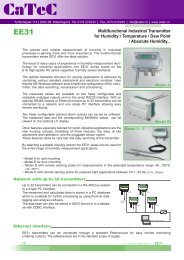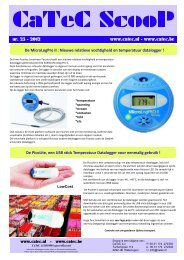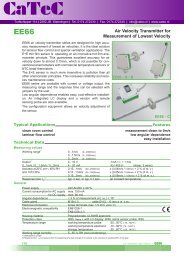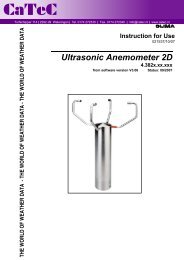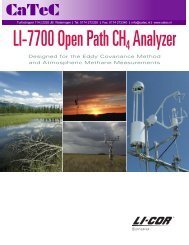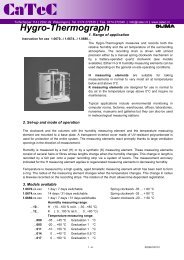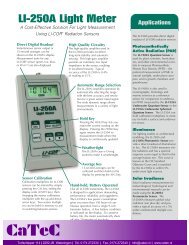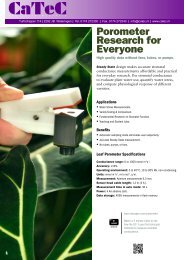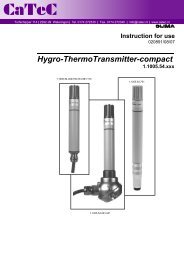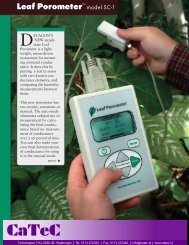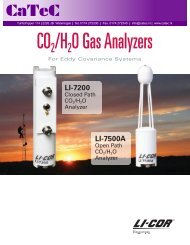li-190sa quantum sensor li-190sa quantum sensor
li-190sa quantum sensor li-190sa quantum sensor
li-190sa quantum sensor li-190sa quantum sensor
Create successful ePaper yourself
Turn your PDF publications into a flip-book with our unique Google optimized e-Paper software.
LI-190SA QUANTUM SENSOR<br />
LI-190SA QUANTUM SENSOR<br />
MEASURE PHOTOSYNTHETICALLY<br />
ACTIVE RADIATION<br />
During photosynthesis, plants use energy in the region of the<br />
electromagnetic spectrum from 400-700 nm (3,9). The radiation<br />
in this range, referred to as<br />
Photosynthetically Active Radiation<br />
(PAR), can be measured in energy units<br />
(watts m -2 ) or as Photosynthetic Photon<br />
Flux Density (PPFD), which has units of<br />
quanta (photons) per unit time per unit<br />
surface area. The units most commonly<br />
used are micromoles of quanta per second<br />
per square meter (µmol s -1 m -2 ).<br />
LI-190SA Quantum Sensor<br />
Plant scientists, horticulturists, ecologists,<br />
and other environmental scientists<br />
use the LI-190SA Quantum Sensor to accurately measure this<br />
variable.<br />
Accurate measurements are obtained under all natural and artificial<br />
<strong>li</strong>ghting conditions because of the computer-tailored spectral<br />
response of the LI-190SA. Colored glass filters are used to tailor<br />
the si<strong>li</strong>con photodiode response to the desired <strong>quantum</strong><br />
response (Figure 1). An interference filter provides a sharp cutoff<br />
at 700 nm, which is critical for measurements under vegetation<br />
where the ratio of infrared to visible <strong>li</strong>ght may be high. A<br />
small response in the infrared region can cause an appreciable<br />
measurement error. This <strong>sensor</strong>, developed from ear<strong>li</strong>er work<br />
(1), was pioneered by LI-COR and has become the standard for<br />
PPFD measurement in most photosynthesis-related studies.<br />
The LI-190SA is also used in oceanography, <strong>li</strong>mnology, and<br />
marine science as a reference <strong>sensor</strong> for comparison to underwater<br />
PAR measured by the LI-192SA Underwater Quantum<br />
Sensor.<br />
* Units currently used are moles, einsteins, photons and quanta (2, 4, 5).<br />
1 µmol s -1 m -2 ≡ 1 µE s -1 m -2 ≡ 6.02 × 10 17 photons s -1 m -2 = 6.02 × 10 17<br />
quanta s -1 m -2 .<br />
PERCENT RELATIVE RESPONSE<br />
100<br />
80<br />
60<br />
40<br />
20<br />
0<br />
ULTRAVIOLET<br />
LI-COR<br />
QUANTUM SENSOR<br />
VIOLET<br />
BLUE<br />
IDEAL QUANTUM RESPONSE<br />
GREEN<br />
400 500 600 700<br />
YELLOW<br />
WAVELENGTH – NANOMETERS<br />
RED<br />
INFRARED<br />
LI-190SA SPECIFICATIONS<br />
Absolute Ca<strong>li</strong>bration: ± 5% traceable to the National Institute of<br />
Standards and Technology (NIST).<br />
Sensitivity: Typical 5µA per 1000 µmol s -1 m -2 .<br />
Linearity: Maximum deviation of 1% up to<br />
10,000 µmol s -1 m -2 .<br />
Stabi<strong>li</strong>ty: Typically < ± 2% change over a<br />
1 year period.<br />
Response Time: 10 µs.<br />
Tilt: No error induced from orientation.<br />
Operating Temperature: -40 to 65°C.<br />
Relative Humidity: 0 to 100%.<br />
Temperature Dependence: 0.15% per °C<br />
maximum.<br />
Cosine Correction: Cosine corrected up to<br />
80° angle of incidence.<br />
Azimuth: < ± 1% error over 360° at 45°<br />
elevation.<br />
Detector: High stabi<strong>li</strong>ty si<strong>li</strong>con photovoltaic detector (blue enhanced).<br />
Sensor Housing: Weatherproof anodized aluminum case with acry<strong>li</strong>c<br />
diffuser and stainless steel hardware.<br />
Size: 2.38 cm Dia. × 2.54 cm H (0.94” × 1.0”).<br />
Weight: 28 g (1 oz).<br />
Cable Length: 3.0 m (10 ft).<br />
ORDERING INFORMATION<br />
The LI-190SA Quantum Sensor cable terminates with a BNC connector<br />
that connects directly to the LI-250 Light Meter or LI-1400 DataLogger.<br />
The 2290 Mil<strong>li</strong>volt Adapter should be ordered if the LI-190SA will be<br />
used with a strip chart recorder or datalogger that measures mil<strong>li</strong>volts.<br />
The 2290 uses a 604 Ohm precision resistor to convert the LI-190SA<br />
output from microamps to mil<strong>li</strong>volts. The Quantum Sensor can also be<br />
ordered with bare leads (without the connector) and is designated<br />
LI-190SZ. Both are available with 50 foot cables, LI-190SA-50 or<br />
LI-190SZ-50. The 2003S Mounting and Leve<strong>li</strong>ng Fixture is recommended<br />
for each <strong>sensor</strong> unless other provisions for mounting are made.<br />
Other accessories are described on the Accessory Page.<br />
LI-190SA Quantum Sensor<br />
LI-190SZ Quantum Sensor<br />
LI-190SA-50 Quantum Sensor<br />
LI-190SZ-50 Quantum Sensor<br />
2290 Mil<strong>li</strong>volt Adapter<br />
2003S Mounting and Leve<strong>li</strong>ng Fixture<br />
2222SB-50 Extension Cable<br />
Figure 1. Typical spectral response of LI-COR Quantum Sensors<br />
vs. Wavelength and the Ideal Quantum Response (equal response<br />
2222SB-100 Extension Cable<br />
to all photons in the 400-700 nm waveband). 1



